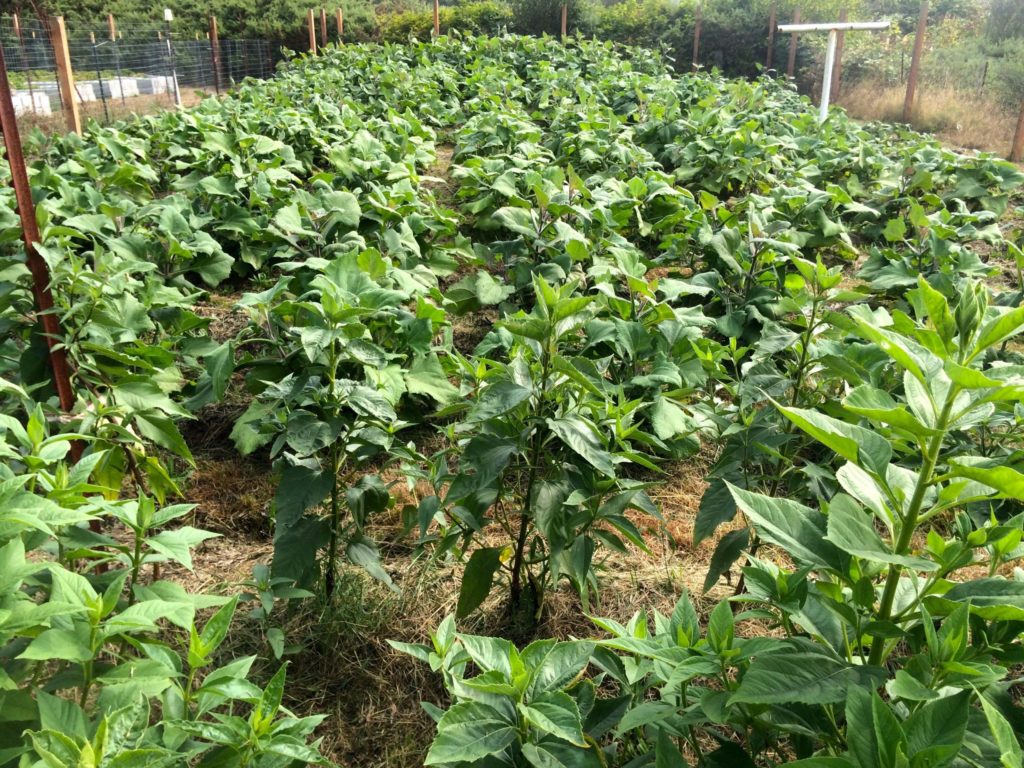Blog, yacon (Smallanthus sonchifolius)
Yacon: Happy in the Heat
This has been a tough year for Andean crops on the Washington coast. The weather has been significantly drier and warmer than any time in the ten years that we’ve lived here. In most years, we look for temperatures to reach into the 70s (Fahrenheit) about twice. This year, we’ve had almost thirty days with temperatures touching 70 or above and a few days in the 80s. That’s really not too much of a problem, although the ulluco has definitely suffered on the hotter days.
The more serious problem has been drought. Although we live on the edge of a temperate rainforest and get more than 100 inches of rain in the average year, we typically get very little rain from May through September. Most of our moisture during that period comes from fog. Consistent high humidity keeps evaporative losses low, so the fog is often enough to allow dry farming here through the summer. This year, there has been almost no fog. We also usually get some rain during the dry period – about 12 inches on average. But this year, the rain has disappeared along with the fog; there has been hardly a drop of rain since April. That has meant a lot of watering, but we’re set up poorly for irrigation, so most plants have been running a deficit. The oca and mashua are smaller than normal. Potatoes are running on the low end of yield. At the moment, the plan is just to keep them wet enough to survive to the end of September when fall rain should start soaking us. Even in a dry year, we’re bound to get more than enough water for the plants to surge back into growth through the fall.
The one Andean plant that has been untroubled by the warmer, drier weather is yacon. While I am constantly hauling hoses around the rest of the field, I’ve only watered the yacon twice this year. It just hasn’t needed much water. The grass around the yacon patch has all gone dormant and brown, while the yacon keeps right on growing.
 Most of the plants are between 3 and 4 feet tall, which is about a month advanced from the usual year. That will probably sound short to those of you who live in warmer climates, but yacon typically doesn’t start to hit 5 feet here until late October. (Planting took place over a three week period, so the plants in the back are taller than those in the front. The plants at the very front of the picture are Jerusalem artichoke seedlings.)
Most of the plants are between 3 and 4 feet tall, which is about a month advanced from the usual year. That will probably sound short to those of you who live in warmer climates, but yacon typically doesn’t start to hit 5 feet here until late October. (Planting took place over a three week period, so the plants in the back are taller than those in the front. The plants at the very front of the picture are Jerusalem artichoke seedlings.)
Along with this unusually fast growth, we’re seeing early flowering in a couple of varieties.
 |
 |
Flower buds on the varieties Morado and Bekya. It looks like both will be flowering fairly heavily by the end of next week. Normally, we don’t see any flowering until well into October, so this is a welcome change. Flowers this early give us a real opportunity to try to get some seed outdoors. Cross your fingers.
Of course, we have a backup plan in the event that cold weather arrives before we can mature yacon seed outdoors.
 We built a greenhouse extension this year primarily for trying to obtain yacon seed. We’ll be able to keep the plants alive year-round in the greenhouse, which should provide a much greater opportunity for making crosses with later-flowering varieties and maturing the seeds without worry of frost ruining the job. The plants are small because they were started from cuttings, but it is going to get very crowded in there by winter.
We built a greenhouse extension this year primarily for trying to obtain yacon seed. We’ll be able to keep the plants alive year-round in the greenhouse, which should provide a much greater opportunity for making crosses with later-flowering varieties and maturing the seeds without worry of frost ruining the job. The plants are small because they were started from cuttings, but it is going to get very crowded in there by winter.
Anyway, yacon lives up to its reputation as one of the more heat and drought tolerant of the Andean tuber crops. It will be interesting to see what our harvest looks like after this unusual weather year.

